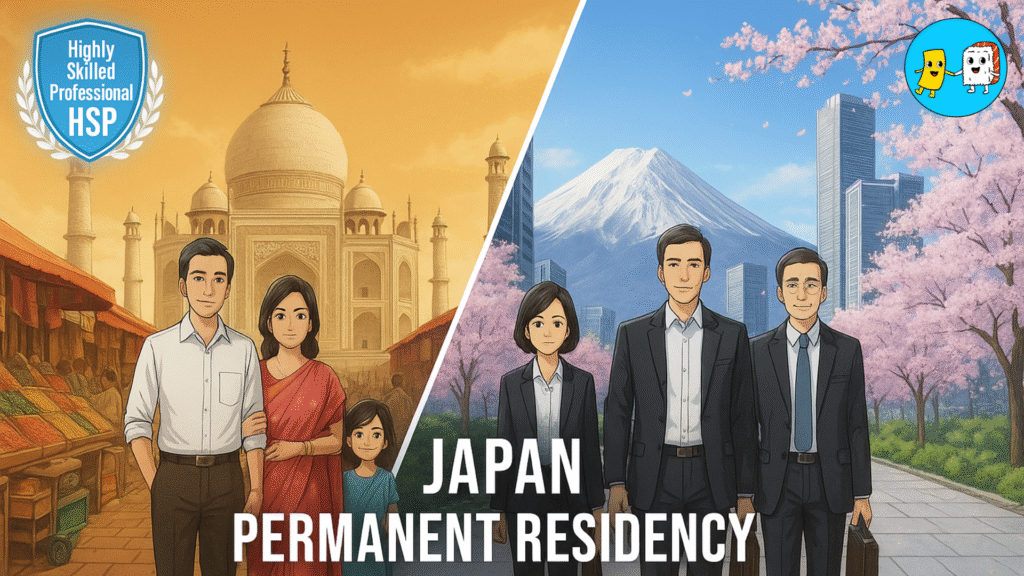Japan Permanent Residency: The Ultimate Guide for Indians (2025 Edition)
皆さん、こんにちは!(Hello everyone!)
Hey everyone, Akash here from Indori in Japan.
So, you’ve settled in Japan. You love the life, the food, the culture… but that visa renewal date on your Residence Card is always in the back of your mind, right? That little bit of tension about gathering documents, waiting for the result, and planning your life in one, three, or five-year chunks.
What if I told you there’s a way to make Japan your permanent home, without giving up your Indian passport? A way to truly put down roots, buy a house, change jobs freely, and live without that visa anxiety.
Chalo, let’s talk about the ultimate goal for many of us here: Japanese Permanent Residency, or as it’s known in Japan, Eijuken (永住権).
This is the most detailed guide you will find on the internet, specifically for our Indian community. We’re going to cover everything—every rule, every pathway, every document, and every pro tip I’ve learned over the years. Bookmark this page, because this is your complete roadmap to getting that coveted Japan Permanent Residency (PR) status.
The Ultimate Goal: Why Japanese PR is the Real Deal
Before we dive into the “how,” let’s be crystal clear about the “why.” Getting Permanent Residency is not just an administrative upgrade; it’s a fundamental change in your life in Japan. It’s about securing a level of freedom and stability that no other visa status can offer.
The Unmatched Freedoms of PR
- Benefit 1: Freedom from Visa Renewals
This is the big one. A Permanent Resident visa is valid for life.1 You will never have to go through the stressful process of renewing your status of residence again. While you do need to renew your physical Residence Card (Zairyu Card) every seven years, this is a simple administrative process, like renewing a driver’s license. It is not a re-evaluation of your eligibility to live in Japan. This removes the single biggest source of long-term uncertainty for foreign residents. The mental relief that comes from this—the psychological freedom to plan your future without the looming anxiety of a visa rejection—is immeasurable. - Benefit 2: Freedom of Work with a standard work visa, such as “Engineer/Specialist in Humanities/International Services,” your employment is restricted to that specific field. If you want to switch to a completely different industry, it can be complicated or impossible. PR removes these shackles entirely. You gain unrestricted employment rights, meaning you can work in any legal job, for any employer. You can change jobs, start your own business, become a full-time freelancer, or even take a sabbatical to explore other interests without worrying about your visa status. This is the key to true professional autonomy in Japan.
- Benefit 3: Financial Freedom and Trust. Obtaining PR signals to Japanese society, especially its financial institutions, that you are a stable, long-term member of the community. This unlocks significant financial opportunities. It becomes dramatically easier to secure loans from Japanese banks for major life purchases like a house or a car, and to get business loans if you’re an entrepreneur. This isn’t just a matter of convenience; it’s the gateway to building long-term wealth and assets in Japan. Banks see you as a low-risk, credible financial entity, allowing you to participate fully in the economy and build a secure future for your family.
- Benefit 4: Stability for Your Family. For those on a spouse visa, your right to live in Japan is tied to your marriage. In the unfortunate event of a divorce or the death of your spouse, your visa status can become precarious. PR provides a crucial safety net. Once you have it, your right to reside in Japan is your own and is not dependent on your marital status, providing immense security and peace of mind.
PR vs. Citizenship: The Best of Both Worlds
This is a critical point for every Indian. Japan does not permit dual citizenship. To become a Japanese citizen, you must renounce your Indian citizenship. For many of us, that’s a step too far.
Permanent Residency offers the perfect solution. It allows you to retain your Indian passport and citizenship while enjoying nearly all the rights of a citizen in Japan. You can live here indefinitely, work freely, and access social systems. The only major rights you don’t have are the right to vote in Japanese elections and to hold public office. You can travel internationally on your Indian passport and maintain your connection to home, all while having a secure, permanent base in Japan. It truly is the best of both worlds.
Path 1: The Standard Route (The 10-Year Journey)
This is the most common and straightforward path for long-term residents. It’s a marathon, not a sprint, based on demonstrating a long-term, stable commitment to living in Japan.
- The Core Rule: You must have lived in Japan for at least 10 consecutive years.
- The Fine Print: This is where many people get confused. It’s not just any 10 years. Within that 10-year period, you must have held a valid work visa (like “Engineer/Specialist in Humanities/International Services”) or a family-based visa (like “Spouse of Japanese National”) for at least 5 consecutive years. This distinction is crucial because it implies that the immigration authorities view your time on these visas as a period of active contribution to Japanese society and its economy. Time spent on a student visa, for example, is seen as “preparatory” and does not count towards this 5-year requirement.
- Maximum Visa Duration: At the time you apply for PR, your current status of residence must have the longest possible period of stay granted for that category. For most work visas, this is currently 3 years or 5 years. This shows the immigration authorities that you are already considered a stable and trusted resident.
A critical point to understand is the meaning of “consecutive” or “continuous” residency. This is a hidden trap. The immigration authorities interpret this very strictly. If you spend too much time outside Japan, your 10-year clock can be reset to zero. While there’s no hard-and-fast rule written in law, the generally accepted limits are:
- A single trip abroad of more than 90 consecutive days.
- A total of more than 100 to 150 days spent outside Japan within any single year.
A long work assignment abroad or an extended family emergency back in India could inadvertently disqualify you. You must maintain Japan as your primary home base throughout the qualifying period.
Path 2: The Family Route (Spouses and Children)
For those with direct family ties to a Japanese national or a Permanent Resident, the path to PR is significantly shorter. This recognises the strong social ties you already have in Japan.
- For Spouses of Japanese Nationals or PR Holders: The 10-year residency rule is completely waived. You are eligible to apply if you have been married for more than 3 years AND have lived in Japan continuously for at least 1 year.
- For Children of Japanese Nationals or PR Holders: The requirement is even more relaxed. You are eligible to apply after having lived in Japan continuously for at least 1 year.
Path 3: The Fast Track (The Highly Skilled Professional - HSP - Points System)
If the 10-year wait seems daunting, this is the express train. Japan is actively seeking to attract and retain top global talent, and the Highly Skilled Professional (HSP) points system is its primary tool. If you can demonstrate your value through a points-based evaluation, you can slash the residency requirement.
- The 70-Point Rule: If you score 70 points or more on the HSP calculation table, the residency requirement drops from 10 years to just 3 years.
- The 80-Point Rule: If you are a high-flyer and score 80 points or more, the residency requirement is cut to an incredible 1 year.
This system essentially creates two distinct classes of PR applicants: those on the standard path, evaluated on longevity and compliance, and those on the HSP path, evaluated on a quantifiable measure of skill and economic contribution. This distinction can even shape career decisions, as someone might pursue a master’s degree or negotiate a higher salary specifically to cross the point threshold and save 7-9 years of waiting.
Hacking the System: A Deep Dive into the HSP Points
Think the 10-year wait is too long? For many skilled professionals from India, especially in IT and management, there’s a much faster way. This is the ‘Jugaad‘ for your PR application—the Highly Skilled Professional (HSP) points system. It’s a bit like a video game where you score points for your skills, education, and salary. Get enough points, and you unlock the PR fast track. Let’s break down how to calculate your score.
The Biggest Secret: The HSP Shortcut Without the HSP Visa
This is the most important thing you need to know about this route, and it’s something many people miss: You DO NOT need to hold the official “Highly Skilled Professional” visa to use this shortcut.
That’s right. If you are on a standard work visa (like “Engineer/Specialist in Humanities/International Services”) but your profile meets the points criteria, you can still apply for PR on the accelerated timeline.
The crucial condition is that you must be able to prove that you met the points threshold (70+ or 80+) at the time of your PR application, AND that you also met it continuously for the required period leading up to your application (i.e., for the past 1 year for the 80-point route, or the past 3 years for the 70-point route). This is a genuine game-changer.
Breaking Down the Points
The points system is a direct reflection of Japan’s economic priorities. It heavily favors a specific profile: a young, highly educated, high-earning professional who is integrated into the Japanese system and works in a high-value field. Let’s see how the points are awarded.
- Academic Background (Max 30 points): A Doctoral Degree gets you 30 points, a Master’s Degree gets 20, and a Bachelor’s gets 10.
- Professional Career (Max 20 points): 10 or more years of relevant work experience is worth 20 points. This scales down to 5 points for 3 years of experience.
- Annual Salary (Max 40 points): This is often the biggest contributor. An annual salary of ¥10 million or more gets you the maximum 40 points. The points decrease with salary, but note that the salary requirement is also linked to your age. For example, to get any points for a salary between ¥4M and ¥5M, you must be under 30 years old.
- Age (Max 15 points): The system clearly prefers younger applicants who can contribute to the workforce for longer. Being under 30 gets you 15 points, while those aged 35-39 get only 5.
- Japanese Language Proficiency (Max 15 points): Passing the JLPT N1 is worth 15 points, and JLPT N2 is worth 10 points. This is a great way to boost your score and show your commitment to integrating into Japanese society.
- Bonus Points: There are several other ways to earn points, such as graduating from a top-ranked university or a Japanese university (+10 points), holding certain Japanese national qualifications (+5 to +10 points), or having published academic papers.
Table: The Ultimate HSP Points Calculator
Use this table to calculate your score. Be honest with your self-assessment.
| Category | Criteria | Points |
|---|---|---|
| Academic Background | Doctoral Degree | 30 |
| Master's Degree | 20 | |
| Bachelor's Degree | 10 | |
| Bonus: Graduated from a Japanese University | +10 | |
| Bonus: Graduated from a top-ranked university | +10 | |
| Professional Career | 10+ years of experience | 20 |
| 7-9 years of experience | 15 | |
| 5-6 years of experience | 10 | |
| 3-4 years of experience | 5 | |
| Annual Salary | ¥10 million or more | 40 |
| ¥9m - ¥9.99m | 35 | |
| ¥8m - ¥8.99m | 30 | |
| ¥7m - ¥7.99m | 25 | |
| ¥6m - ¥6.99m | 20 | |
| ¥5m - ¥5.99m | 15 | |
| ¥4m - ¥4.99m | 10 | |
| Age | 29 or younger | 15 |
| 30 - 34 | 10 | |
| 35 - 39 | 5 | |
| Language Ability | JLPT N1 or equivalent | 15 |
| JLPT N2 or equivalent | 10 | |
| Japanese National Qualification | 2 or more | 10 |
| 1 qualification | 5 |
Verdict:
- 70+ Points: You may be eligible for PR after 3 years of residency.
- 80+ Points: You may be eligible for PR after just 1 year of residency.
The Unbreakable Rules: Core Requirements for Every Applicant
No matter which path you take—the 10-year marathon or the 1-year sprint—there are some rules that are absolutely non-negotiable. The immigration officers are extremely strict about these. Think of this section as the ‘board exams’ for your PR application. You have to pass every single subject.
Rule 1: Good Conduct (Being a Good Citizen)
You must demonstrate that you are a law-abiding resident. This means you must have a clean record with no criminal history in Japan or abroad.
- The Traffic Violation Trap: This is a major pitfall. Good conduct extends to your driving record. While a single minor parking ticket from years ago is unlikely to be a problem, a pattern of recent violations will be a huge red flag. The unofficial rule of thumb is that if you have around 5 or more violations in the past 5 years, or 4 in the past 2 years, your application is at high risk of rejection. If you’re unsure, you can get a copy of your complete driving record (unten kiroku shoumeisho) from a police station.
Rule 2: Financial Stability (Proving You Can Stand on Your Own Feet)
You must prove that you have a stable income or sufficient assets to live independently in Japan without becoming a public burden.
- The Magic Number: While there is no officially published minimum income, the widely accepted benchmark is a stable annual income of at least ¥3 million for a single applicant. This income must be consistent over the required review period (e.g., the last 5 years for the standard route, the last 1-3 years for the HSP route).
- For Families: If you have dependents (spouse or children), you need to show a higher household income. A common guideline is to add approximately ¥500,000 to ¥700,000 to the minimum for each dependent you support.
Rule 3: Paying Your Dues (The #1 Reason for Rejection)
Listen carefully, because this is the most important rule and the number one reason why PR applications are rejected. You must have fulfilled all your public obligations. This means you have paid your income tax, resident tax, national pension premiums, and health insurance premiums in full.
- The “On-Time” Clause: It is not enough to have simply paid them. You must have paid them BY THE DEADLINE, EVERY SINGLE TIME. The immigration authorities will check the exact dates of payment. Even one late payment, by a single day, can be grounds for rejection. This isn’t just about financial solvency; it’s used as a key indicator of your character and reliability. A person who consistently meets their deadlines is seen as a responsible member of society who can be trusted with the privileges of permanent residency.
- Akash’s Advice: The best way to avoid any accidental mistakes is to go to your bank and set up automatic withdrawals (jido haraikomi) for any payments that aren’t deducted directly from your salary. This is a simple step that can save your application. Furthermore, this intense scrutiny extends to your entire household. The tax and pension payment records of your spouse (even if they are a Japanese national) will also be reviewed. This forces a level of financial transparency within the family. An applicant cannot succeed alone; their entire household must be in perfect compliance.
Rule 4: The Guarantor (Mimoto Hoshonin)
You must have a guarantor (mimoto hoshonin) to support your application. This person must be either a Japanese national or an existing Permanent Resident.
- Clarifying the Role: Many people get scared when they hear the word “guarantor,” thinking it’s like co-signing a loan. It’s crucial to understand and explain to your potential guarantor that their role is moral, not legal or financial. They are not legally responsible for your debts or actions. By signing the Letter of Guarantee, they are simply providing a character reference to the government, attesting that you are a responsible person.
- Simplified Paperwork: In the past, guarantors had to provide a mountain of paperwork. Thankfully, the process has been simplified. Now, your guarantor typically only needs to fill out and sign the official Letter of Guarantee and provide a copy of their official ID (like a driver’s license or residence card). This makes it much easier to ask a boss, a senior colleague, or a trusted friend to help you.
The Ultimate Checklist: Preparing Your Bulletproof Application
Alright, theory class is over. It’s time for the practicals. This section is your ultimate checklist for putting together a perfect, bulletproof application. The application process itself is a test of your diligence and organisation. A neat, complete, and well-organised file signals to the immigration officer that you are a serious and responsible applicant.
The Step-by-Step Process
- Step 1: Gather Your Documents. This is the most time-consuming part. Use the master checklist below and start collecting everything. Pay close attention to the validity periods—most documents must be issued within 3 months of your application date.
- Step 2: Find Your Guarantor. Do this early. Explain their role clearly using the information above, emphasising that it is a moral, not financial, responsibility and that the paperwork is now very simple.
- Step 3: Write Your Statement of Reason (Riyūsho). This is your chance to tell your story. In a free format, explain your history in Japan, why you want to live here permanently, your contributions to your company and community, and your future plans.
- Step 4: Submit at Your Local Immigration Bureau. The application must be submitted in person at the regional Immigration Services Agency office that has jurisdiction over your address.
- Step 5: The Waiting Game. The standard processing time is anywhere from 4 to 8 months, and sometimes longer. During this time, it is critical to remember that your PR application does not automatically extend your current visa. If your current Residence Card is due to expire while you are waiting, you must apply for a regular extension of your current visa.
- Step 6: Approval and Fee. If your application is approved, you will receive a postcard in the mail. You will then take this postcard, your passport, and your current residence card back to the immigration office. You will need to pay an ¥8,000 fee by purchasing a revenue stamp (shunyu inshi) at the office to receive your new Permanent Resident card.
Table: Master Document Checklist for Japan PR Application
This table is your best friend. Use it to track every single document.
| Category | Document Name (English) | Document Name (Japanese / Romaji) | Where to Obtain | Akash's Notes |
|---|---|---|---|---|
| Personal & Basic | Application Form for Permanent Residence | 永住許可申請書 (Eijū Kyoka Shinseisho) | Immigration Website / Office | Ensure you use the correct form based on your current visa status. |
| Photograph (4cm x 3cm) | 写真 (Shashin) | Photo Booth / Studio | Must be a clear, recent photo taken within the last 3 months. Write your name on the back. | |
| Passport & Residence Card | パスポート・在留カード (Pasupōto / Zairyū Kādo) | - | You will need to present the originals at the time of submission. | |
| Certificate of Residence | 住民票 (Jūminhyō) | Your local City/Ward Office | Request the version for your entire household (setai zen-in). Crucially, ask them to omit the "My Number" (Individual Number). | |
| Statement of Reason | 理由書 (Riyūsho) | You write this yourself | Free format. If not in Japanese, a translation is required. Tell your story here. | |
| Employment & Income | Certificate of Employment | 在職証明書 (Zaishoku Shōmeisho) | Your Employer | If you are self-employed, you must submit your business license and tax returns intead. |
| Resident Tax Certificates (Assessment & Payment) | 課税証明書 & 納税証明書 (Kazei Shōmeisho & Nōzei Shōmeisho) | Your local City/Ward Office | You need these for the required number of years (5 for the standard route, 3 for the 70-point HSP, 1 for the 80-point HSP).25 They prove your income and that you paid your local taxes. | |
| National Tax Payment Certificate | 納税証明書 (その3) (Nōzei Shōmeisho Sono San) | Your local Tax Office (Zeimusho) | This certificate proves you have no unpaid national taxes (like income tax). | |
| Proof of Assets | 資産証明 (Shisan Shōmei) | Your Bank, Legal Affairs Bureau, etc. | Copies of your bank passbook (tsucho), real estate registration certificate, etc.. | |
| Social Security | Pension Payment Records | ねんきん定期便 (Nenkin Teikibin) or ねんきんネット (Nenkin Net) printout | Japan Pension Service office or website | This is critical. You must provide records for the most recent 2 years showing that all payments were made on time. |
| Health Insurance Card (Copy) | 健康保険証のコピー (Kenkō Hokenshō no kopii) | Your Employer / City Office | A copy of the front and back of your card. If you are on National Health Insurance (Kokumin Kenko Hoken), you must also provide proof of premium payments for the last 2 years. | |
| Guarantor | Letter of Guarantee | 身元保証書 (Mimoto Hoshōsho) | Immigration Website / Office | Must be filled out and signed/stamped by your guarantor. |
| Guarantor's ID (Copy) | - | Your Guarantor | A copy of their Driver's License, Residence Card (if PR), etc.. | |
| Route-Specific | Family Registry (if married to a Japanese national) | 戸籍謄本 (Koseki Tōhon) | Your spouse's registered City/Ward Office | This is the official family register and is required for the spouse route. |
| HSP Points Calculation Sheet | ポイント計算表 (Pointo Keisan-hyō) | Immigration Website / Office | You must submit this with evidence for each point claimed if you are using the HSP fast track. |
Akash's Pro Tips: Avoiding Rejection and Ensuring a Smooth Process
You’ve reached the final boss level! Your documents are ready, and you’re about to submit. Before you do, let’s go over some pro tips from my side to maximise your chances of success and avoid the common mistakes that get so many applications rejected. Suno, dhyaan se!
Recap: Top 5 Reasons for PR Application Rejection
Let’s quickly review the main pitfalls we’ve discussed. Your application will be in trouble if:
- Your Income is Too Low: You fail to consistently meet the unofficial ¥3 million/year threshold (plus dependent allowance).
- You Paid Taxes or Pension Late: This is the #1 application killer. Even one missed deadline in the review period is a major problem.
- You Spent Too Much Time Outside Japan: You broke the “continuous residency” rule by travelling too much.
- You Have a Bad Driving Record: A pattern of traffic violations shows a lack of good conduct.
- Your Application is Inconsistent or Incomplete: Your Statement of Reason doesn’t align with your documents, or you’re missing required paperwork.
- Rule 1: Start Preparing Years in Advance. PR is a marathon, not a sprint. The evaluation period covers years of your life in Japan. Start living as if you’re being evaluated today. Pay every bill on time, drive safely, maintain stable employment, and keep good records. The best time to start preparing for your PR application was a few years ago. The second-best time is now.
- Rule 2: Be Your Household’s CFO (Chief Financial Officer). Remember, your entire household is under review. Before you even start gathering documents, have an open and honest conversation with your spouse. You need to be 100% sure that their tax and pension payment history is also perfect for the required period.
- Rule 3: Craft a Compelling “Statement of Reason”. Your application is not just a collection of forms; it’s a narrative. The documents provide the data, but the Statement of Reason provides the context and tells your story. Don’t just write “I want to live in Japan because it is nice.” Be specific. Talk about your connection to your local community, your professional achievements and future goals, your family life, and your long-term commitment to being a positive contributor to Japanese society. This is your one chance to speak directly to the immigration officer who holds your future in their hands.
- Rule 4: When in Doubt, Explain. If you have a potential red flag in your application—for example, a year of low income because you were studying, or a necessary extended trip back to India for a family emergency—don’t hide it. Address it head-on. Include a separate, brief letter explaining the circumstances, along with any supporting evidence you might have. Transparency is always better than letting the officer assume the worst.
- Rule 5: Learn Some Japanese. While not a mandatory requirement for the standard or spouse routes, demonstrating an effort to learn the language is always viewed favourably. It shows your commitment to integrating into Japanese society. For the HSP route, it’s a direct way to earn valuable points that could cut years off your waiting time.
Getting PR is a long and meticulous process, but it is absolutely achievable. It’s a test of your patience, diligence, and commitment to your life in Japan. The system is designed to reward those who are stable, responsible, and well-integrated members of society. By following these rules, you are not just preparing an application; you are demonstrating that you are exactly the kind of person Japan wants as a permanent resident.
Follow this guide, be meticulous with your paperwork, and you will get there. I’m rooting for you!
If you have any questions, drop them in the comments below. I’ll do my best to help. All the best!
✍️ Bonus: Need Help Starting?
✅ Job hunting tips and real listings for foreigners in Japan
✅ Visa guidance made simple—no confusing search
✅ Resume & cover letter templates (Japanese & English formats)
✅ Life in Japan explained — from rent to ramen
✅ Travel guides & city recommendations for every kind of explorer
✅ Work culture insights to help you adjust and thrive





